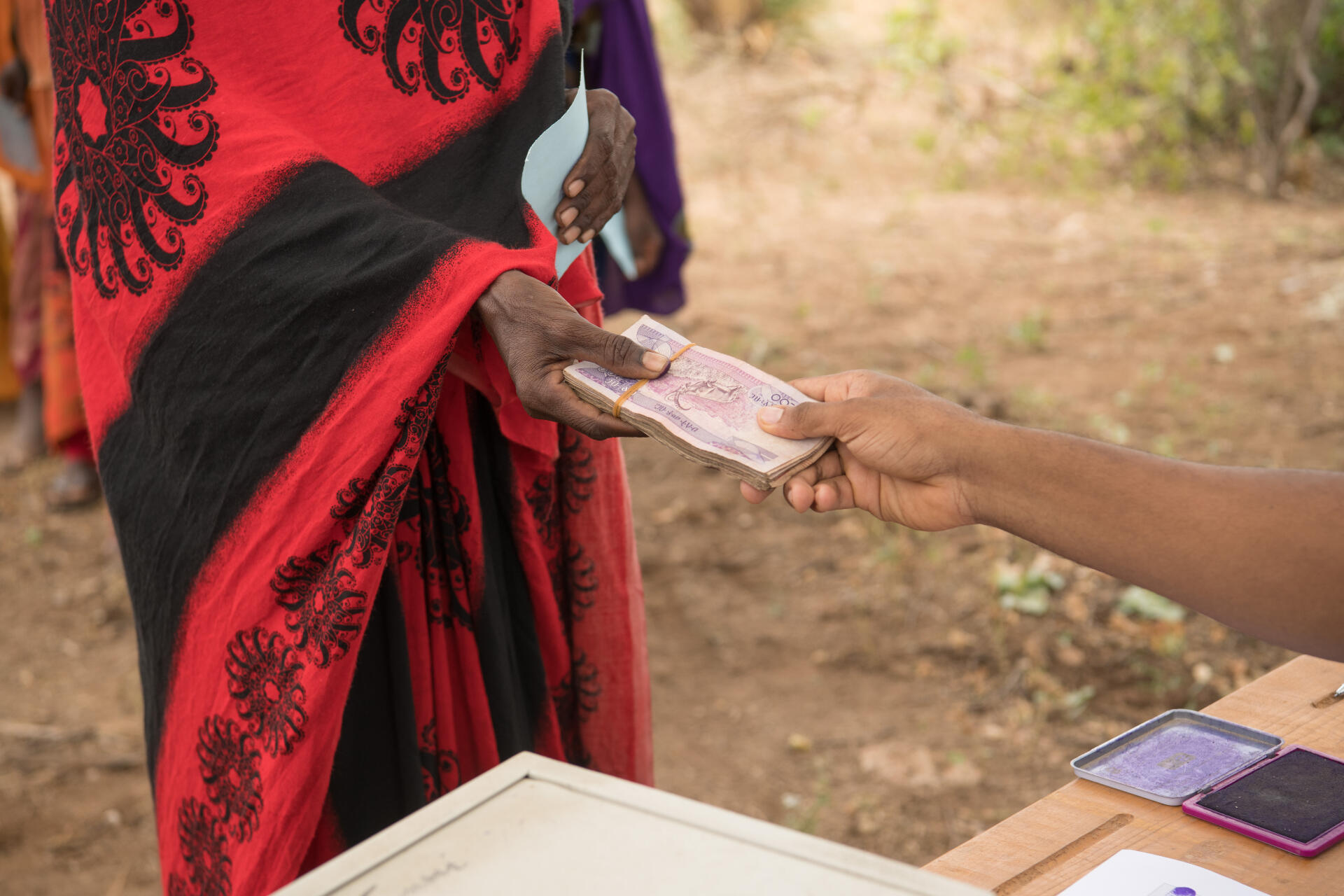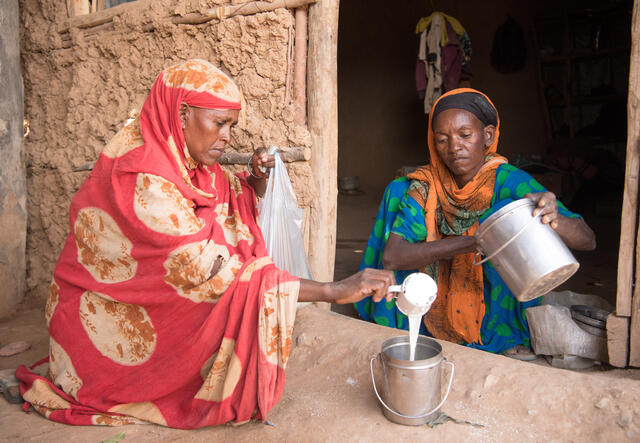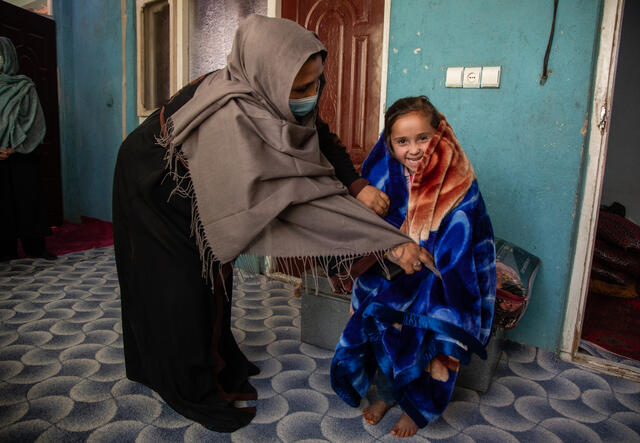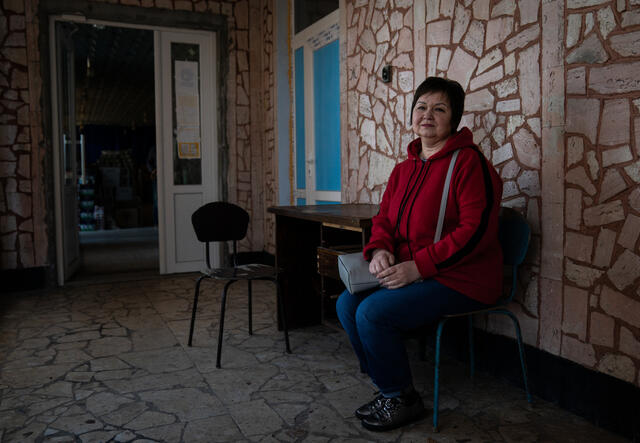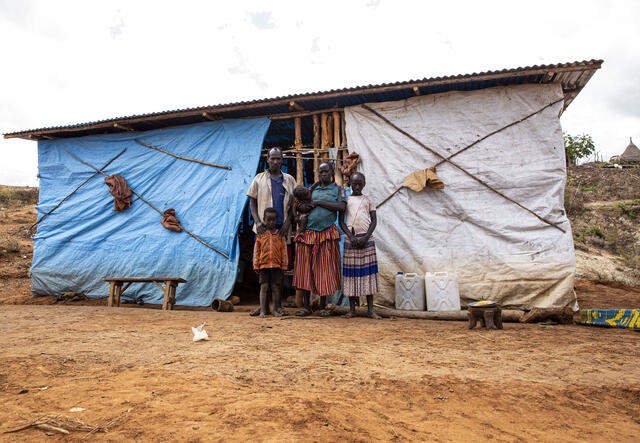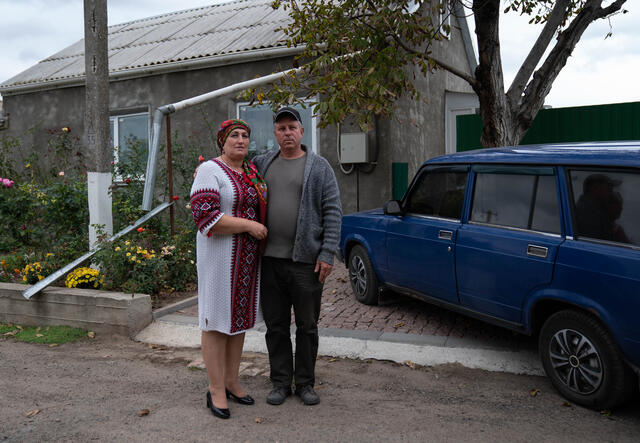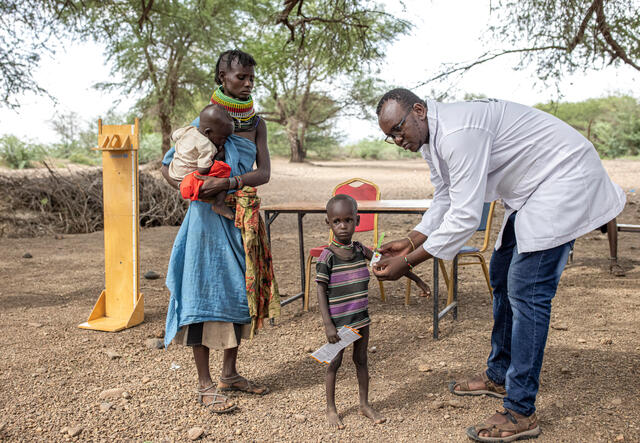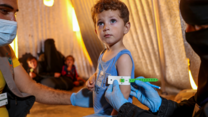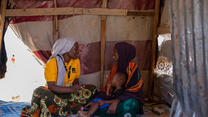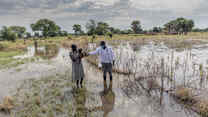The IRC is committed to helping people whose lives and livelihoods are shattered by conflict and disaster, to survive, recover and gain control over their future. This often involves delivering humanitarian assistance, sometimes known as humanitarian aid, to communities in need worldwide.
When a crisis strikes, the IRC delivers humanitarian assistance that promotes health, safety, economic well being, education and empowerment, with special programming designed to benefit women and girls adopted throughout our response framework.
For 90 years, the IRC has assessed crises and determined how to support those in need. This includes providing cash and voucher assistance — tools that are becoming increasingly prevalent in the IRC’s programming.
Read on to learn more about how the IRC delivers cash and voucher assistance to people experiencing crisis.
Nurad Gulana Abdi (left) was a farmer in Kulan Challe Village, Ethiopia before she and her family were displaced by severe drought and flooding. Now residing in the Dirrey camp for internally displaced people, Nurad receives cash assistance from the IRC and uses it to buy food for her family.
Photo: Maheder Haileselassie for the IRC
What is cash assistance?
Providing cash directly to crisis-affected individuals is a dignified and effective form of humanitarian aid. Organizations like the IRC identify people who are in need of cash assistance and work to deliver physical or electronic payments to them.
Cash assistance is different from in-kind humanitarian assistance, which is what many people think of when they hear the terms “humanitarian aid” or “humanitarian assistance.” In-kind humanitarian assistance refers to the delivery of tangible goods, like food, shelter materials and water, to people in need.
Clare Clingain, a senior research coordinator for the IRC and Airbel Impact Lab, led a 2023 study that examined the impact of giving cash assistance to vulnerable people before the onset of a climate shock. Her research indicates that this form of support, called anticipatory cash assistance, can increase a recipient’s ability to adapt to climate shocks, establishing it as a promising intervention in reducing vulnerability.
“Cash assistance, much like the cash that we use in our everyday lives, allows people to do with it what they like and meet what needs they see fit,” says Clingain.
In Kabul, Afghanistan, Noor* wraps her daughter in a new blanket that she was able to purchase after receiving emergency cash assistance from the IRC. Noor, who lost her husband to a bombing during Afghanistan’s 2021 change in government, says, “I bought two blankets. Today I want to buy tea, sugar, onions, and things we need — it means that my kids will not starve to death.”
Photo: Kellie Ryan for the IRC
What is voucher assistance?
Similar to cash assistance, voucher assistance gives recipients flexibility in deciding how to meet their own needs within a predetermined range of goods or services, such as food or medical treatment. Organizations like the IRC distribute vouchers that can be redeemed to purchase services or products from a verified vendor.
Why does the IRC give cash and voucher assistance?
Since the 1940s, the IRC has recognized the importance of providing direct cash assistance to people in need, starting with Varian Fry and his team distributing cash to those fleeing the Nazis during WWII.
In 2022, the IRC distributed over $80 million worth of cash and voucher assistance to people in more than 30 countries. Each IRC cash and voucher distribution program is customized to fit the specific needs of those receiving aid.
Direct cash and voucher assistance empowers recipients, fuels the local economy and is a cost-effective form of humanitarian assistance.
Larysa* was displaced from her apartment in Mykolaiv, Ukraine and now lives with her elderly parents in their home. She uses cash assistance provided by the IRC to purchase food for her family and medicine for her mother, who is bedridden and battling cancer.
Photo: Diana Zeyneb Alhindawi
Cash empowers people
Giving cash directly to people in need of humanitarian aid empowers them to determine and meet their most pressing needs, boosting the effectiveness of the response.
“When people receive cash assistance, they are completely free to establish their own priorities. Not only choosing if they want to buy food, water or go to the hospital but also deciding what kind of food they are buying for example,” the IRC’s deputy director of cash and markets, Stefano Battain. “This is more dignifying and also has the advantage of contributing to the local economy.”
Unfounded myths have called cash assistance into question, citing concerns that these funds could allow recipients to purchase things like cigarettes and alcohol.
“The evidence shows that the cash is resoundingly spent on food or critical services that people need to live their lives,” says Clingain. A review of 30 studies found that cash assistance did not impact whether or not people purchased “temptation goods” like alcohol and drugs.
Gedeno* and his family were forced to move to the Baide Belebela site for internally displaced people in Ethiopia after ethnic conflict broke out near their home. “The IRC supported me with cash and I was able to buy scholastic materials for my children,” says Gedeno.
Photo: Fahmo Mohammed for the IRC
Cash fuels the local economy
In many crisis-affected communities, a lack of cash prevents people from buying essential goods from local markets. Direct cash assistance stimulates the local economy and helps people purchase necessary goods.
“Whereas in-kind aid can disrupt local markets and economies by undercutting local vendors, cash assistance has a more positive effect,” says Battain.
Cash assistance can boost local economies by increasing purchases, production, and by creating new businesses and employment opportunities.
The IRC's Resilient Futures program provides vulnerable entrepreneurs with business training courses and grants to start small businesses. In turn, new business owners employ sustainable business practices and contribute to the local economy by hiring employees.
Cash is cost-effective
Direct cash assistance is a highly cost-effective method of delivering humanitarian aid. The IRC can circumvent logistical costs associated with delivering in-kind aid by providing cash or vouchers.
“A lack of infrastructure is a major challenge associated with delivering in-kind humanitarian assistance in places like Somalia, Cameroon or Burkina Faso,” says Battain. “However, you can easily move cash from the north of the country to the south using a mobile phone within a matter of seconds.”
The IRC has also partnered with banks, technology companies and other financial-service institutions to establish safe, easy-to-use options such as prepaid ATM cards and mobile money.
Olga and her husband hide in the basement of their home, which lies near the contact lines of the war in Ukraine, when the fighting intensifies. Olga, who has cancer, uses the cash assistance she receives from the IRC to buy medicine.
Photo: Diana Zeyneb Alhindawi for the IRC
Why does the IRC provide other kinds of humanitarian assistance?
While providing direct cash assistance brings several benefits, it can not effectively meet all humanitarian needs.
“Cash assistance may facilitate transport to a hospital, but it can’t replace the provision of medical services or be exchanged for food if none is available,” says Clingain.
In cases where the fallout of a crisis can not be managed with cash, service provision or in-kind aid may be better suited to support people in need.
An example of in-kind aid: addressing malnutrition
To address the global child malnutrition crisis, the IRC has adopted a protocol that trains local health care workers and community leaders to diagnose and treat children experiencing malnutrition.
When diagnosed, malnutrition is treated with ready-to-use therapeutic food (RUTF), but it may not be available locally. Cash assistance helps vulnerable families provide nutritious food to their children to prevent malnutrition, but it may be less impactful during natural disasters or when food is unavailable in local markets.
While cash assistance can meet the needs that arise from many crises, direct in-kind assistance and service provision remain crucial to saving lives.
Find out more about the IRC’s malnutrition protocol.
Nutritionist Sammy* screens Lokyioto’s son, Kaliba, for signs of malnutrition in the outskirts of Turkana, Kenya. “I’ve been taking my children to the clinic for the last three months,” says Lokiyoto. “I hope they can grow well so that they can look after themselves when I’m not around.”
Photo: Patrick Meinhardt for the IRC
How can I deliver assistance to people in need?
The IRC’s mission is to help people whose lives and livelihoods are shattered by conflict and disaster, to survive, recover and gain control over their future — but we can’t do it alone.
Consider donating today to support the IRC and help us deliver assistance in more than 40 crisis-affected countries around the world.
*Last name excluded for privacy
